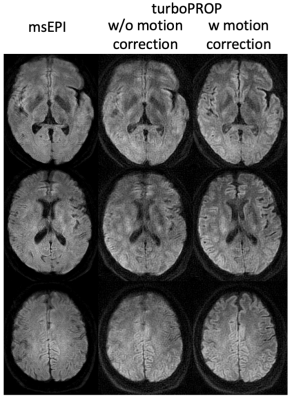Zhiqiang Li1, Melvyn B Ooi2, and John P Karis1
1Neuroradiology, Barrow Neurological Institute, Phoenix, AZ, United States, 2Philips Healthcare, Gainesville, FL, United States
1Neuroradiology, Barrow Neurological Institute, Phoenix, AZ, United States, 2Philips Healthcare, Gainesville, FL, United States
A whole-blade turboPROP was developed to increase the blade width, and consequently the scan speed by a factor of ~2, relative to the original turboPROP. Increased blade width also enables robust motion correction. In vivo data demonstrate advantages over ssEPI, msEPI, and SPLICE-PROPELLER.

Fig. 4. (a) compares overall image quality of 4 techniques and (b) shows a special case in the presence of metal. In (a), ssEPI shows strong signal pileup, which is reduced but still present in msEPI. Signal pileup is minimized in turboPROP (with slight signal drop off) and SPLICE-PROPELLER. SNR of turboPROP is much better than SPLICE-PROPELLER, while slightly lower than but still close to msEPI. (b) shows images from a volunteer with a surgical patch that causes signal pile up in ssEPI and msEPI, which is not visible in turboPROP. T2 TSE is acquired as reference

Fig. 5. Capability of motion correction with turboPROP. Image quality of both msEPI (left column) and turboPROP (middle column) are degraded by rigid body motion. With motion correction (including both PROPELLER motion correction of each source image and image registration between diffusion directions), the motion artifacts can be minimized (right column, same raw data as the middle column).
